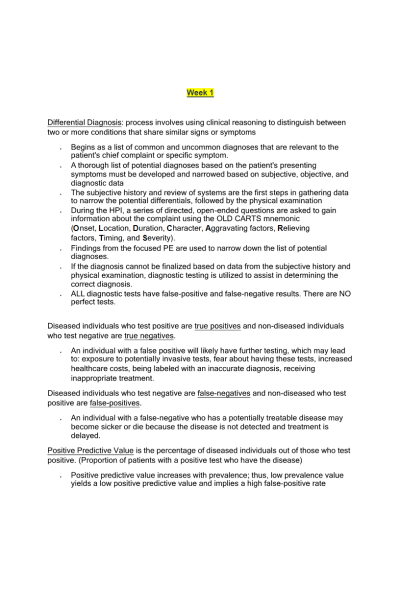NR 576 Week 4 Midterm Study Guide
-
$25.00
| Institution | NR 576 Differential Diagnosis in Adult-Gerontology Primary Care Practicum |
| Contributor | Maggio |
Week 1
Differential Diagnosis: process involves using clinical reasoning to distinguish between two or more conditions that share similar signs or symptoms
- Begins as a list of common and uncommon diagnoses that are relevant to the patient's chief complaint or specific symptom.
- A thorough list of potential diagnoses based on the patient's presenting symptoms must be developed and narrowed based on subjective, objective, and diagnostic data
- The subjective history and review of systems are the first steps in gathering data to narrow the potential differentials, followed by the physical examination
- During the HPI, a series of directed, open-ended questions are asked to gain information about the complaint using the OLD CARTS mnemonic
(Onset, Location, Duration, Character, Aggravating factors, Relieving factors, Timing, and Severity).
- Findings from the focused PE are used to narrow down the list of potential diagnoses.
- If the diagnosis cannot be finalized based on data from the subjective history and physical examination, diagnostic testing is utilized to assist in determining the correct diagnosis.
- ALL diagnostic tests have false-positive and false-negative results. There are NO perfect tests................... Continue
Week 2
It is important to use specific terminology to describe skin lesions and rashes. Good descriptions include each of the following elements: number, size, color, shape, texture, primary lesion, location, and configuration
- Number—solitary or multiple; estimate of total number
- Size—measured in millimeters or centimeters
- Color—including erythematous if blanching; if non-blanching, vascular-like cherry angiomas and vascular malformations, petechiae, or purpura
- Shape—circular, oval, annular, nummular, or polygonal
- Texture—smooth, fleshy, verrucous, or warty, keratotic; greasy if scaling
- Primary lesion—flat, a macule or patch; raised, a papule or plaque; or fluid filled,
a vesicle or bulla (may also be erosions, ulcers, nodules, ecchymoses, petechiae, and palpable purpura)
- Location—including measured distance from other landmarks
- Configuration—grouped, annular, linear................... Continue
Week 3:
Allergic Conjunctivitis: Inflammation of the conjunctiva due to allergies
- Itching is the most consistent sign
- Also characterized by red eyes and other allergic disease symptoms such as sneezing
Bacterial Conjunctivitis:
- Red, itchy eyes are associated with this condition, as is purulent or mucopurulent discharge in one or both eyes.
Toxic Conjunctivitis: Inflammation of the conjunctiva due to medications, chemicals, or toxins can cause red, itchy eyes.............. Continue
Week 4:
Hearing Loss: occurs when there is a partial or complete inability to perceive sound in one or both ears
- Sensorineural
- Presbycusis
- Ototoxic drugs
- Noise exposure
- Head trauma
- Metabolic or Autoimmune
- Not reversible*
- Treatment
- There is no proven or recommended treatment or cure for sensorineural hearing loss; management of hearing loss is usually by hearing strategies and hearing aid.
- Referral to audiology is appropriate.
- In cases of profound or total deafness, a cochlear implant is a
specialized hearing aid that may restore a functional level of hearing.................... Continue
| Instituition / Term | |
| Term | Year 2022 |
| Institution | NR 576 Differential Diagnosis in Adult-Gerontology Primary Care Practicum |
| Contributor | Maggio |








